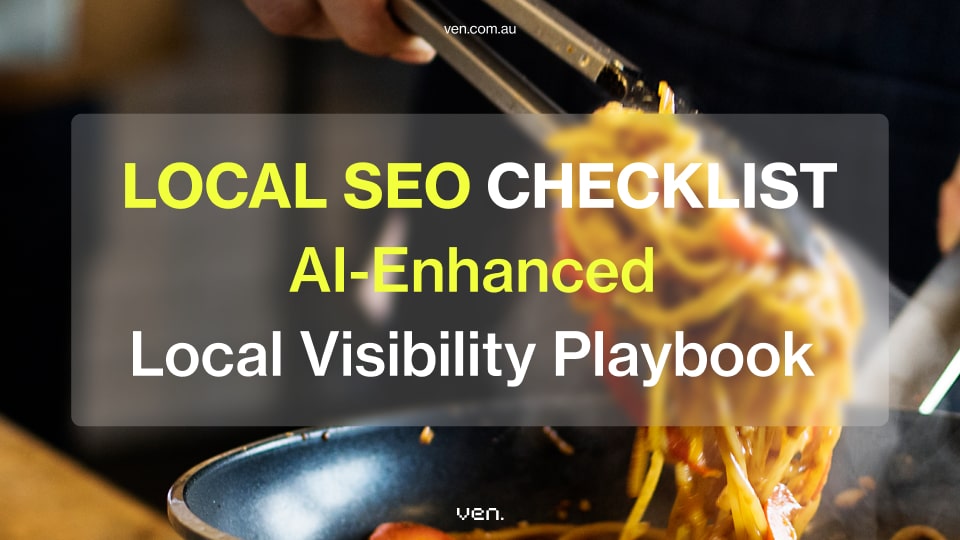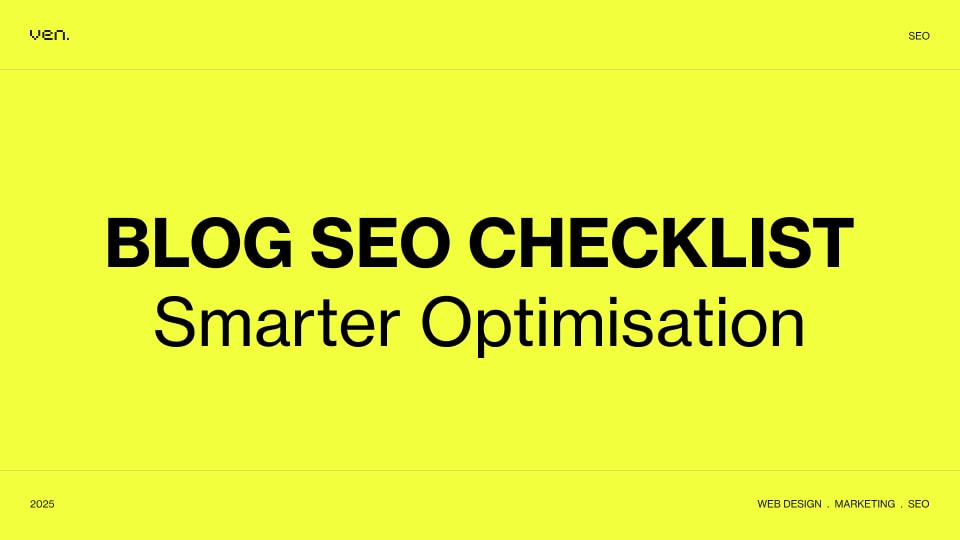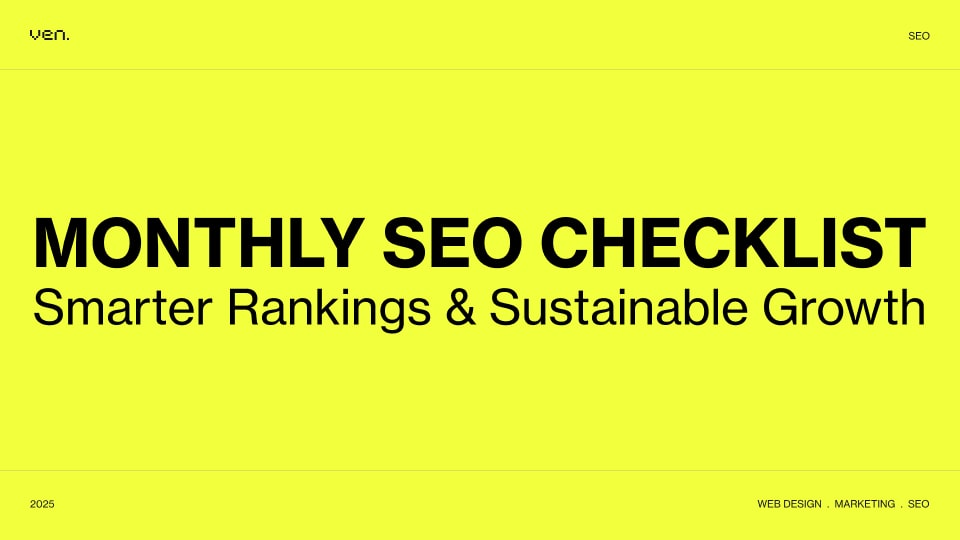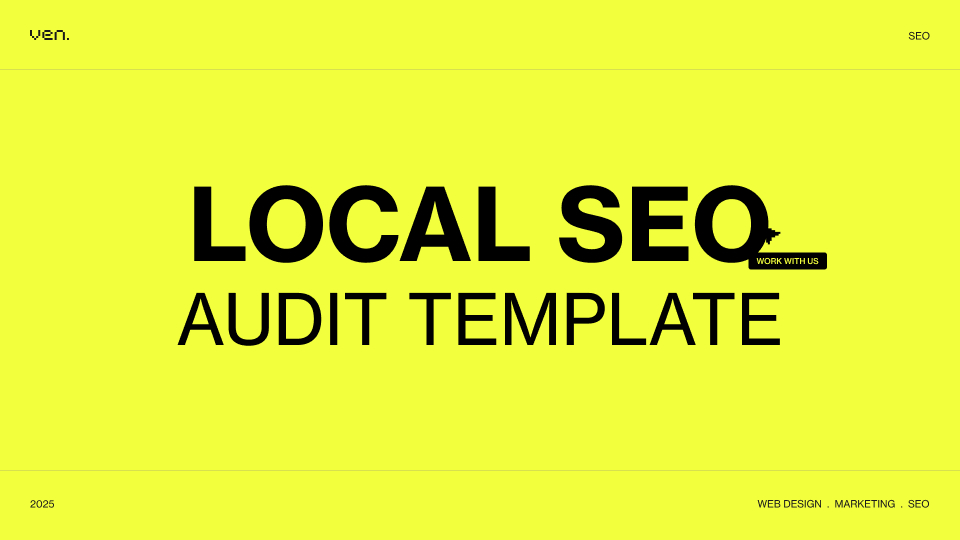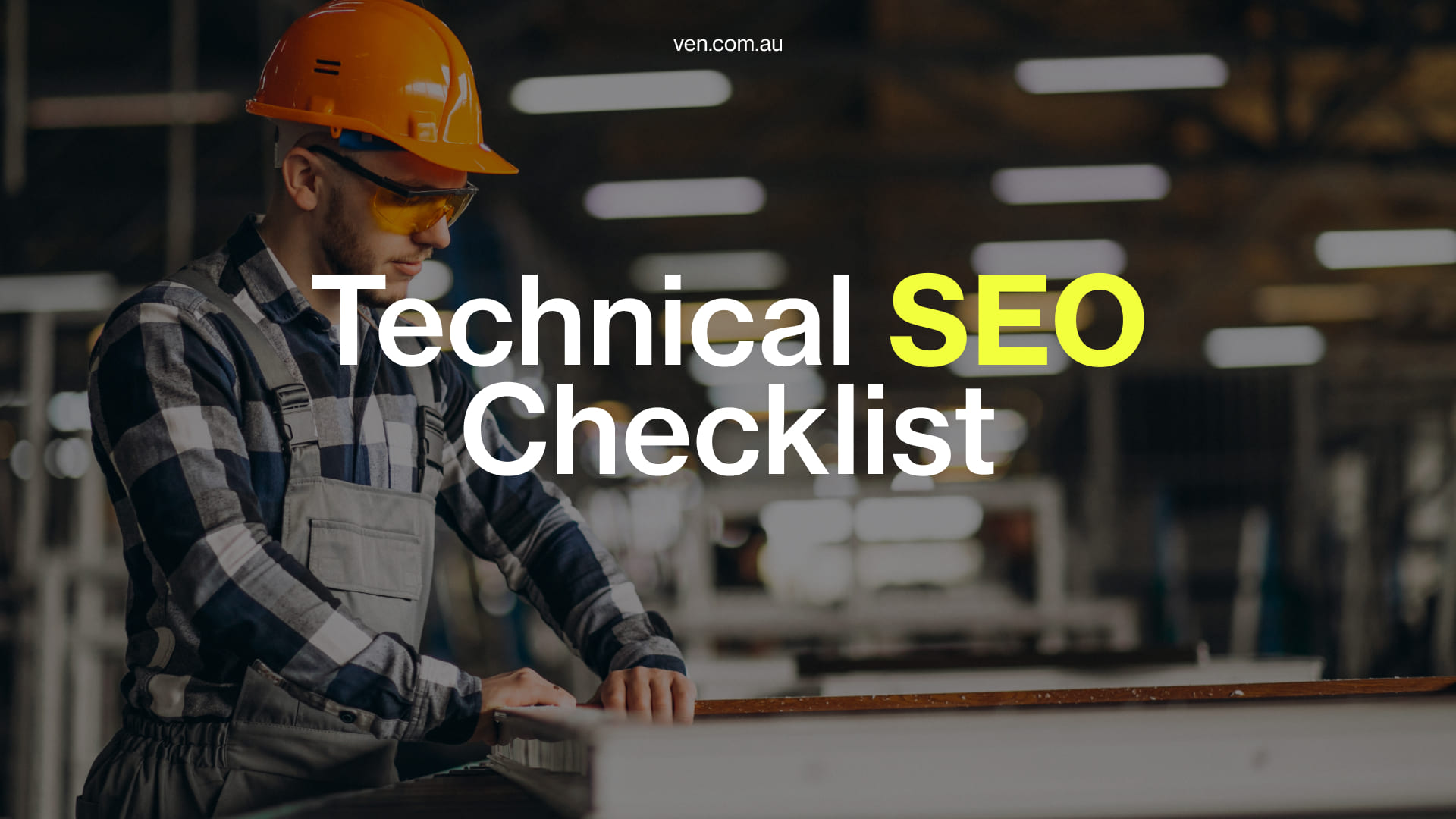Your next customer isn’t browsing. They’re searching: “café near me,” “builder in Geelong,” “accountant Marrickville.” And if your business isn’t showing up in those moments, you’re invisible. This Local SEO checklist helps your business show up in the right searches, earn trust faster, and turn visibility into bookings, calls, and visits.
But here’s what’s different in 2025: they’re not just typing into Google anymore.
- They’re asking ChatGPT for recommendations.
- They’re using AI voice assistants while driving.
- They’re relying on AI-curated content in their social feeds, emails, and smart home hubs.
Local search is no longer about keywords alone, it’s about context, presence, and trust at the moment of intent.
This playbook helps your business show up where it counts, whether that’s a Google Map result, a voice prompt, or an AI-generated list of “top-rated mortgage brokers in Brisbane.”
1. Local SEO Checklist Essential #1: Build a High-Performance Website That AI and Search Engines Trust
Your website is your digital shopfront. If it’s slow, hard to navigate, or vague about what you offer and where, you’re leaking opportunities. AI tools like ChatGPT and Bing Copilot also assess how your site performs, what it communicates, and whether it deserves to be recommended when someone searches for your type of business.
Make sure you:
- Use responsive design: Most local searches happen on mobile, and if your site feels clunky or misaligned on smaller screens, users will bounce, and AI won’t recommend you. A responsive layout ensures consistency and professionalism across phones, tablets, and desktops.
- Keep load speed under 3 seconds: Page speed affects both rankings and user experience. Use Pagespeed Insights and Core Web Vitals tools to pinpoint what’s slowing your site down, oversized images, slow scripts, or unnecessary code, and fix them fast. A fast site performs better in Google and is more likely to be pulled into AI-generated responses.
- Create clear service and location pages: Don’t rely on one “Services” page. Break out each core service, like “Kitchen Renovations” or “Tax Returns for Sole Traders”, into its own optimised page. If you serve multiple suburbs, create pages for each one. AI and search engines rely on this structure to understand what you offer and where.
- Make URLs clean and keyword-friendly: Each location or service page should have a simple, readable URL structure that includes relevant local keywords, like /plumbing-south-yarra or /electrician-brisbane.
- Include contact info on every page: Make it easy for customers to reach you, no matter which page they land on. Add a click-to-call phone number, your business email, and your physical location in the footer or header. Embed a Google Map on your contact page, and clearly show business hours and service areas. These details also help build trust in AI-powered answers.
- Use local business schema: Implement Schema.org structured data on your website to define key business details. This includes your business name, address, phone number, opening hours, service area, and reviews. LocalBusiness schema helps Google and AI platforms like ChatGPT identify your relevance for local queries.
- Add page-level structured data: Use schema for individual services, FAQs, and products where relevant. For example, you can mark up your FAQ section with FAQ schema or apply Service schema to describe your offerings more clearly.
- Ensure your site is crawlable and indexable: Make sure your robots.txt file and sitemap are configured properly. Submit your sitemap to Google Search Console and check for crawl errors or indexing issues regularly.
We helped a trades company serving Sydney’s Inner West reduce homepage load time by 1.8 seconds using insights from SEMrush’s Core Web Vitals report. The result? Visitors stayed longer and enquiries increased by 22%.
2. Local SEO Checklist Must-Have: Optimise Your Google Business Profile for Maximum Impact
A key part of any Local SEO Checklist is your Google Business Profile (formerly Google My Business). It’s a free, essential platform that helps your business appear in Google Search and Maps, where local customers are already looking for services like yours.
Think of your GBP as your 24/7 sales rep. It’s often the first thing people see before they ever visit your site.
Get it right by:
- Claiming and verifying your Google Business Profile: Head to google.com/business and make sure you’ve claimed your listing. Until it’s verified, you can’t manage your information or respond to reviews, which means you’re not fully in control of how your brand appears.
- Filling out every field, not just the basics: Include your full business name (exactly as it appears on your signage), phone number, physical address, website, business hours (including holiday hours), service area (if applicable), and business categories. Every field you leave blank is a missed opportunity for Google and AI platforms to connect you with the right customers.
- Uploading authentic, high-quality photos and videos: Show the real experience—your team in action, your storefront, your products, or even behind-the-scenes shots. Profiles with photos get more engagement and are easier for searchers to trust at first glance.
- Choosing accurate attributes and keeping them up to date: Add relevant tags such as “wheelchair accessible,” “pet-friendly,” “women-led,” or “appointment required.” These not only help set expectations but also increase your chances of appearing in filtered results or AI-generated recommendations.
- Auditing and maintaining consistency across the web: Use SEMrush’s Listing Management tool to check for NAP inconsistencies (name, address, phone) across all directories. Fixing mismatches helps boost your authority and local ranking.
- Regularly posting updates: Share seasonal offers, business news, or community involvement every week. Google favours active, accurate profiles—and so do real people.
One Brisbane café we worked with hadn’t updated its profile in over a year. After verifying their listing, uploading new menu photos, and posting weekly specials, they saw a 35% lift in calls and map direction requests within a month.
3. Local SEO Checklist Step 3: Create Location Pages for Every Area You Serve
If your business has multiple locations or services a broad area, you need dedicated pages for each suburb or region. A single “Our Locations” page is not enough. Search engines want specificity. So do your customers.
Creating individual location pages helps you rank for local searches, shows that you’re established in the area, and improves user experience by giving people the details they need.
Whether you operate brick-and-mortar stores or are a service-based business with no physical premises, these pages let you speak directly to each community.
Here’s what to include on each location page:
- Your business name and suburb clearly stated: For example, use “Joe’s Coffee Shop – Fitzroy” or “Joe’s Plumbing Services in Brunswick.” This helps with both branding and local keyword relevance.
- An embedded map: Place a Google Map that pinpoints your exact location or service area. This makes it easy for customers to get directions and helps Google understand your geographic focus.
- Local keywords throughout the page: Include the suburb or city name in your page title, headings, meta description, and content. Use phrases like “your local plumber in Richmond” or “reliable house cleaning in Glen Waverley.”
- Customer reviews from that location: Show testimonials from clients in the area. This builds social proof and gives your page more local credibility.
- Photos relevant to that location: Add images of the storefront, interior, or completed projects. For service businesses, use job photos from that area to give visitors a sense of your work in their own community.
These pages are not just about SEO. They create a personalised experience for each audience and help turn local searchers into loyal customers.
4. Local SEO Checklist Step 4: Optimise On-Page Content with Local Keyword Strategy
Your content is what tells both Google and AI tools that your business is locally relevant and deserves to be surfaced in response to specific, place-based searches. But just dropping in a suburb name isn’t enough. Local SEO success requires precision, structure, and search-informed language.
Here’s how to do it right:
- Start with local keyword research: Use Keyword Tools to find what people are already searching in your area. Look for long-tail, specific terms, like “emergency plumber Brunswick” or “best vegan café in Fitzroy”—that show buyer intent.
- Use the Google search bar itself: Begin typing your service and location (e.g., “hairdresser St Kilda”) and take note of Google’s autocomplete suggestions. Explore the “People Also Ask” and “Related Searches” sections for fresh ideas.
- Check what you already rank for: Google Search Console can reveal terms you might already be visible for. Optimising those pages further may lead to quick wins.
- Analyse competitors: Discover which keywords they rank for—and you don’t—so you can close the gap or find untapped opportunities.
- Infuse primary and supporting keywords into high-value locations:
- Title tags
- Meta descriptions
- H1 headings
- URL slugs
- First paragraph of content
- Image ALT tags
- Structure your content clearly: Use H2 and H3 tags for services and subtopics. This makes it easier for users to skim—and for AI tools to parse.
- Create service area pages: Build individual pages for each suburb or district you serve, with unique content tied to that area.
- Don’t forget the essentials: Make sure your NAP (name, address, phone) is visible on every page. Embed a map and link to directions on your contact or location page.
- Track performance: Use Google Analytics to monitor impressions, bounce rates, and conversions. This tells you what’s resonating—and what needs refining.
A landscaping business in Perth added “backyard paving Applecross” to their homepage copy after keyword research. Within a few weeks, they began ranking for multiple nearby suburbs and booking new leads they’d never reached before. Local content works when it speaks the language people are actually using.
5. Local SEO Checklist Step 5: Strengthen Your Authority with Link Building
Think of this step as your local trust signal. Search engines look for signs that other reputable, relevant websites and your broader online ecosystem to recognise your business. That comes down to two things: consistent citations and high-quality local backlinks.
Let’s break it down.
Start with Citations: Get Your Info Right, Everywhere
A “citation” is any mention of your business’s name, address, and phone number (NAP) on another website. And consistency matters; mismatched listings confuse both Google and customers.
Here’s what to do:
- Start by reviewing your online citations: these are mentions of your business name, address, and phone number across directories and platforms. Inconsistent information can confuse search engines and undermine trust with potential customers. A manual audit is a great place to start, or you can speed things up with platforms like SEMrush’s Listing Management. Begin with high-traffic Australian directories like Yellow Pages, TrueLocal, Yelp AU, and local council business listings.
- Fix any inconsistencies you find: even small variations like “Suite 5” / “Unit 5” or “Street” / “St” can send mixed signals. Your NAP (Name, Address, Phone) should match exactly across every listing.
- Claim all your profiles: unclaimed listings can be edited by the public or left outdated, which can cost you leads and credibility.
- Keep everything current: if you change locations, adjust your hours, or update your contact details, reflect those changes on every platform. Think of these listings as digital storefronts—they need maintenance just like your real one.
Getting this right builds confidence and trust. It’s one of the simplest but most important steps in your Local SEO Checklist.
We worked with a Northcote osteopathy clinic that had two conflicting Google listings. After merging and updating them, their local impressions nearly doubled, and calls from Maps rose 40%.
Build Local Links: Earn Your Reputation
Backlinks (when other websites link to yours) are one of the strongest SEO signals. But for local SEO, relevance matters more than volume. You want links from your community, not random blogs or overseas directories.
Here’s how to build the right links:
- Sponsor local events, sports teams, or charities: These usually include mentions on community websites or media pages.
- Write guest posts for local blogs or newsletters: Share expertise on topics that matter to your area—think “renovating for resale in the Northern Beaches.”
- Collaborate with nearby businesses: For example, a real estate agent teaming up with a local architect for a co-branded blog series benefits both.
- Reclaim unlinked brand mentions: Use SEMrush’s Backlink Audit Tool to find where you’ve been mentioned online but not linked, and ask for a backlink.
- Diversify your sources: Aim for a healthy mix of backlinks from directories, community blogs, business associations, and supplier pages.
- Use localised anchor text: When possible, links should include your suburb or service (e.g., “Brighton wedding florist”).
One Newcastle landscaping firm we worked with earned four strong local backlinks from supplier directories and media mentions. Their domain authority jumped, and they cracked the top three for “landscaper Newcastle”, a position they hadn’t touched before.
When done right, these off-site signals help Google – and AI tools – connect the dots: you’re credible, you’re local, and you’re the best match for the search.
6. Local SEO Checklist Step 6: Use Reviews to Build Trust, Boost Visibility, and Drive Action
Reviews influence rankings, click-throughs, and conversions. They are your reputation — and your edge.
Reviews are more than feedback. They represent your online reputation, your credibility in the community, and a powerful signal for local SEO. For many people, reviews are the first real impression of your business. In many cases, they are the deciding factor in whether someone contacts you or keeps searching.
Search engines prioritise businesses with frequent, high-quality reviews. People do too. A strong review profile sends a message that you are trustworthy, active, and recommended by others in your area.
Here’s how to make reviews a core part of your Local SEO Checklist:
- Ask for reviews consistently: Make review requests part of your standard process. After each service or sale, follow up with an email or text message that includes a direct link to your Google review page. You can also convert that link into a QR code and place it on printed materials like business cards or thank-you notes.
- Choose the right review platform: For most businesses, Google should be the priority because it directly impacts your visibility in search results and on Google Maps. Depending on your industry, you might also focus on platforms like Tripadvisor, Yelp, or Facebook.
- Reply to every review: Respond professionally and promptly to both positive and negative feedback. It shows you care about your customers and take their experiences seriously.
- Display your best reviews: Add a review widget to your website or feature customer testimonials in your content and social updates. Positive feedback creates trust long before a customer ever picks up the phone.
- Monitor your reviews regularly: Check Google, Facebook, and any other relevant platforms often. If you are using a review management tool, make sure it can track and organise feedback from multiple sources.
A healthcare business we worked with in Melbourne launched a simple review follow-up email. Within two months, they grew from 14 to 82 reviews and climbed from sixth to second position in Google’s map pack.
Reviews are not just a reflection of your brand. They are part of your brand. And they deserve just as much attention as your homepage or your signage.
7. Local SEO Checklist Step 7: Build Local Citations and Strengthen Your Local Presence
While not a direct ranking factor, social media plays a supporting role in your local SEO efforts. It keeps your brand top-of-mind in your community, builds relationships, and drives traffic to your site.
Here’s how to get more from your social presence:
- Post about local events and news: Sharing updates related to your suburb or city connects your brand to the community and helps you stay relevant in conversations that matter to locals.
- Highlight local partnerships: Showcase collaborations with other businesses or organisations. Tag them, thank them, and encourage them to engage with your posts. This expands your reach and builds trust through association.
- Engage with your followers: Respond to comments, answer questions, and take part in local discussions. This builds loyalty and signals that your business is active and approachable.
- Use local hashtags: Include city, suburb, or region-specific hashtags in your posts to make them more visible to nearby audiences.
Whether it’s a Facebook post celebrating a local market or a Google Business Profile update about your new holiday hours, every action helps shape how your brand is seen online—and locally. Consistency and presence build trust, and trust builds clicks.
You’re Not Just Showing Up. You’re Leading.
Local SEO isn’t a one-and-done checkbox. It’s how you become the trusted choice in your area. It’s visibility with a purpose. It’s your name at the right time, in the right place, with the right message.
If you’re ready to turn these insights into action, we’re here to help. From strategy to execution, we’ve helped Australian brands across dozens of industries get found and chosen.
